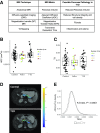Pancreas Volume Declines During the First Year After Diagnosis of Type 1 Diabetes and Exhibits Altered Diffusion at Disease Onset
- PMID: 30552135
- PMCID: PMC6341292
- DOI: 10.2337/dc18-1507
Pancreas Volume Declines During the First Year After Diagnosis of Type 1 Diabetes and Exhibits Altered Diffusion at Disease Onset
Abstract
Objective: This study investigated the temporal dynamics of pancreas volume and microstructure in children and adolescents with recent-onset type 1 diabetes (T1D) and individuals without diabetes, including a subset expressing autoantibodies associated with the early stages of T1D.
Research design and methods: MRI was performed in individuals with recent-onset stage 3 T1D (n = 51; median age 13 years) within 100 days after diagnosis (mean 67 days), 6 months, and 1 year postdiagnosis. Longitudinal MRI measurements were also made in similarly aged control participants (n = 57) and in autoantibody-positive individuals without diabetes (n = 20). The MRI protocol consisted of anatomical imaging to determine pancreas volume and quantitative MRI protocols interrogating tissue microstructure and composition.
Results: Within 100 days of diabetes onset, individuals with T1D had a smaller pancreas (median volume 28.6 mL) than control participants (median volume 48.4 mL; P < 0.001), including when normalized by individual weight (P < 0.001). Longitudinal measurements of pancreas volume increased in control participants over the year, consistent with adolescent growth, but pancreas volume declined over the first year after T1D diagnosis (P < 0.001). In multiple autoantibody-positive individuals, the pancreas volume was significantly larger than that of the T1D cohort (P = 0.017) but smaller than that of the control cohort (P = 0.04). Diffusion-weighted MRI showed that individuals with recent-onset T1D had a higher apparent diffusion coefficient (P = 0.012), suggesting a loss of cellular structural integrity, with heterogeneous pancreatic distribution.
Conclusions: These results indicate that pancreas volume is decreased in stages 1, 2, and 3 of T1D and decreases during the first year after diabetes onset and that this loss of pancreatic volume is accompanied by microstructural changes.
Trial registration: ClinicalTrials.gov NCT03585153.
© 2018 by the American Diabetes Association.
Figures



References
-
- Chiarelli F, Verrotti A, Altobelli E, Blasetti A, Morgese G. Size of the pancreas in type I diabetic children and adolescents. Diabetes Care 1995;18:1505–1506 - PubMed
-
- Gepts W. Pathologic anatomy of the pancreas in juvenile diabetes mellitus. Diabetes 1965;14:619–633 - PubMed
-
- Williams AJ, Thrower SL, Sequeiros IM, et al. . Pancreatic volume is reduced in adult patients with recently diagnosed type 1 diabetes. J Clin Endocrinol Metab 2012;97:E2109–E2113 - PubMed
Publication types
MeSH terms
Substances
Associated data
Grants and funding
LinkOut - more resources
Full Text Sources
Other Literature Sources
Medical

